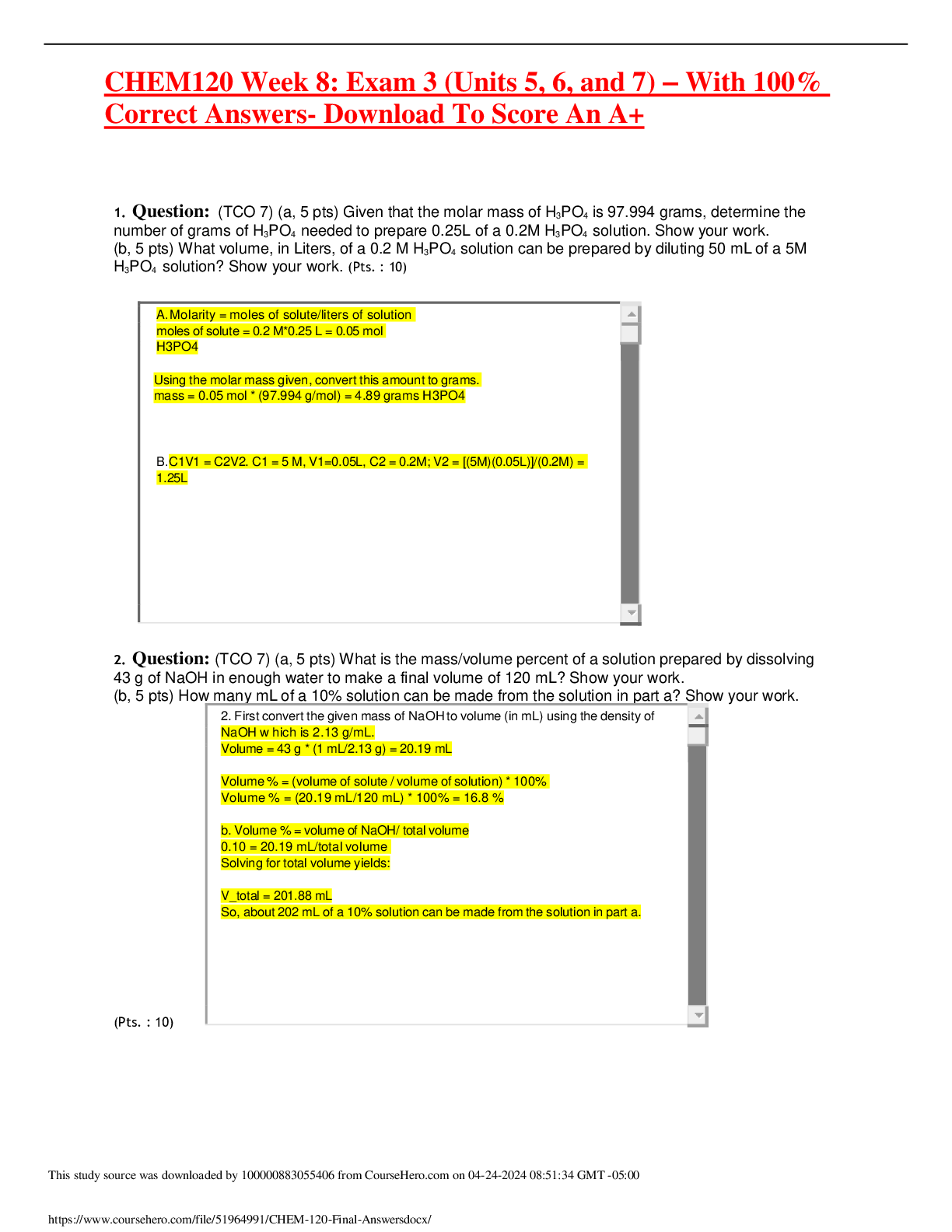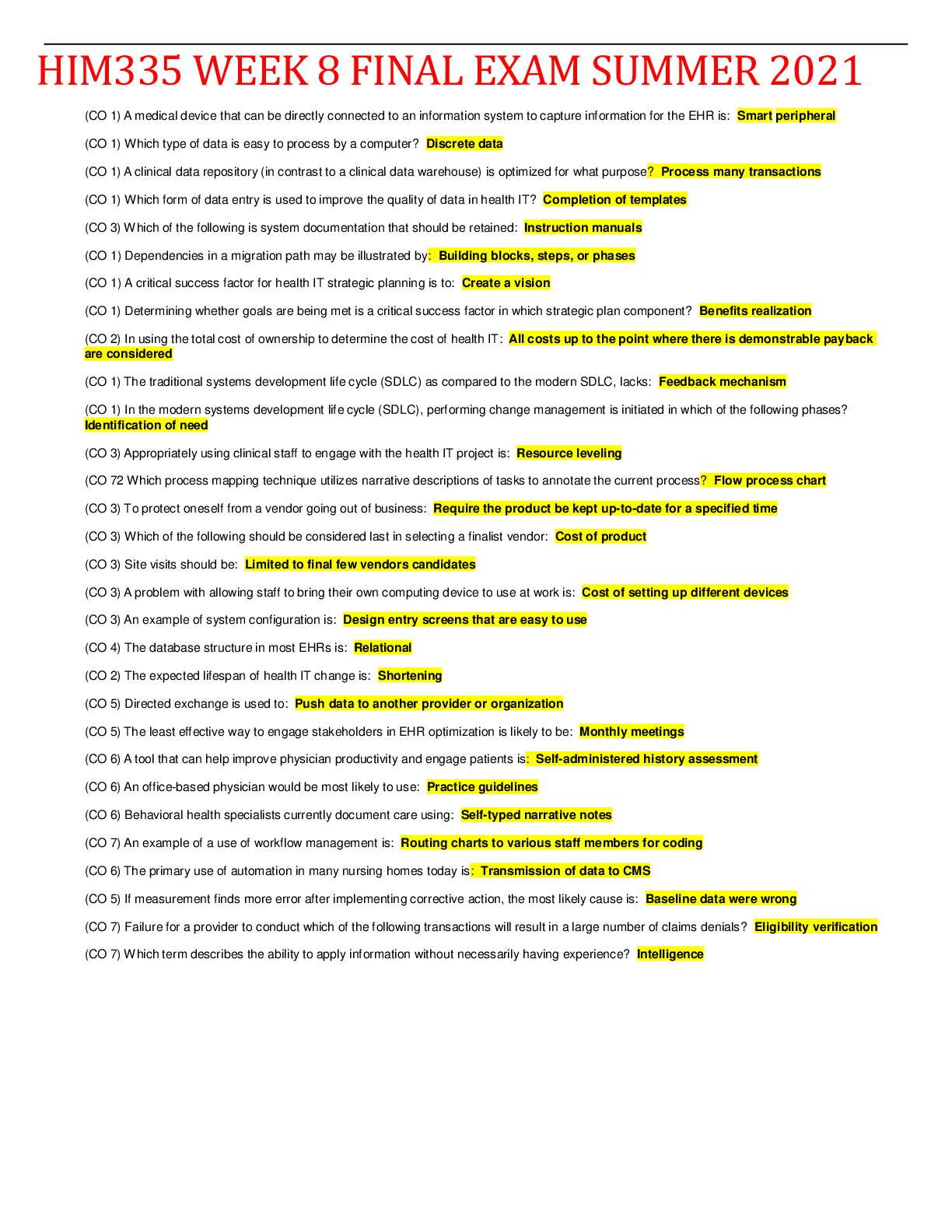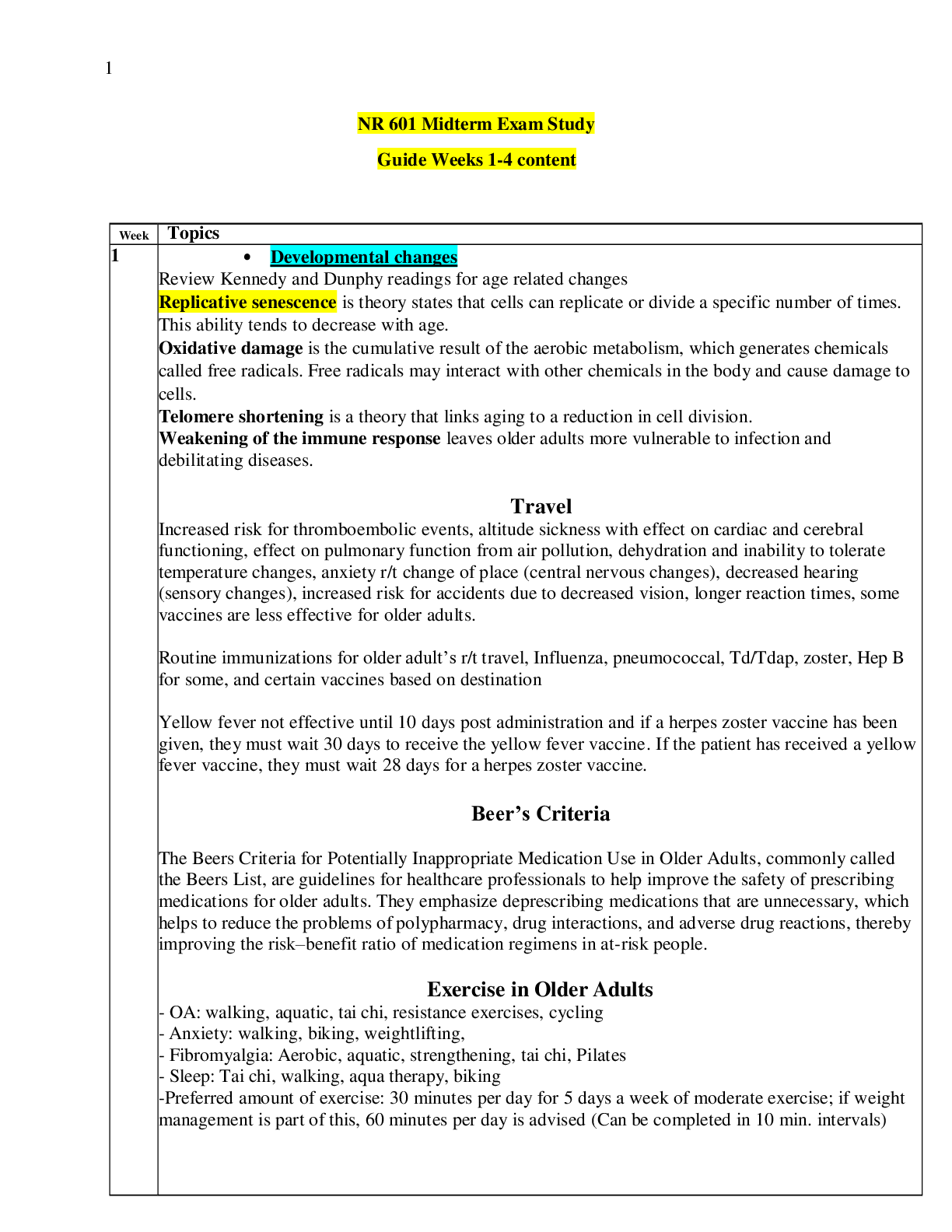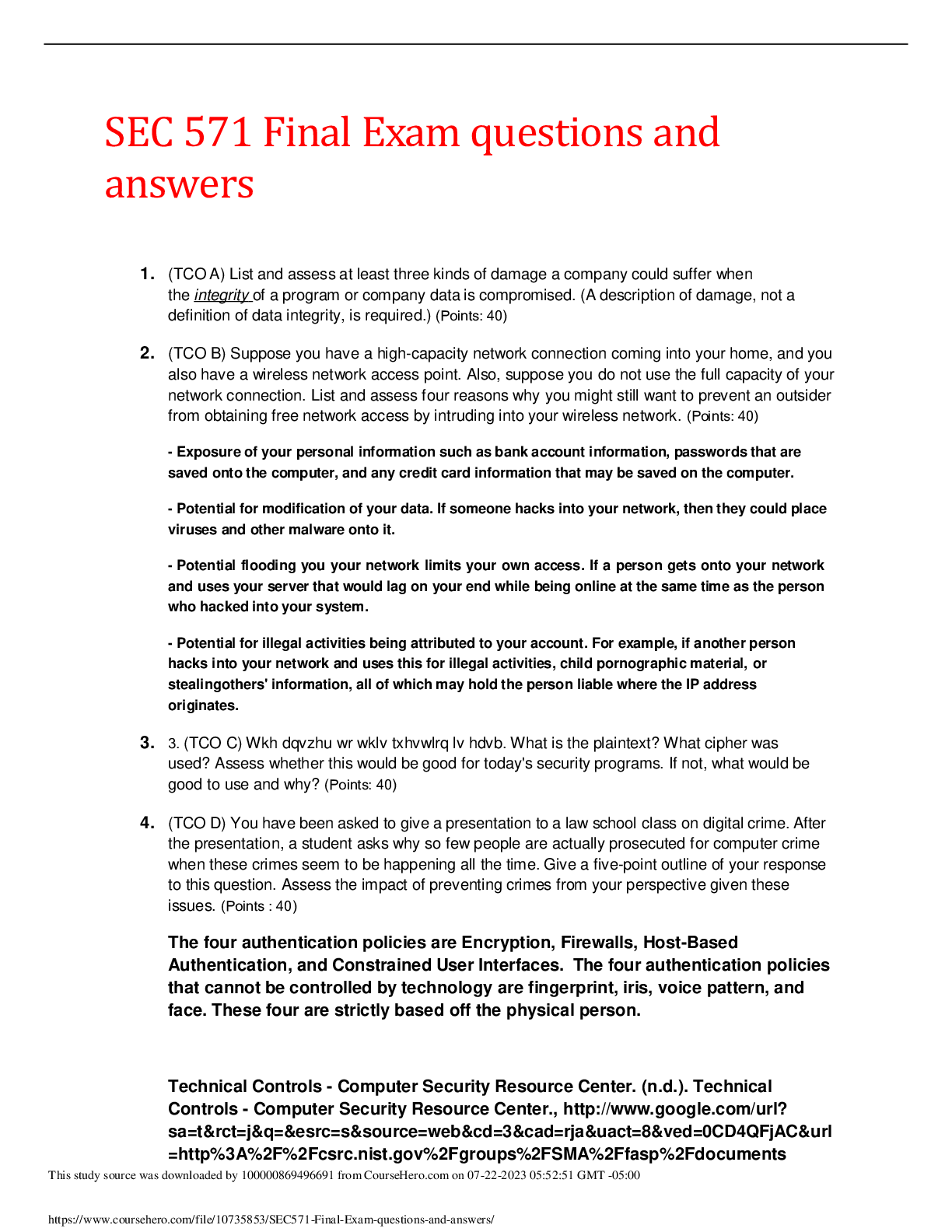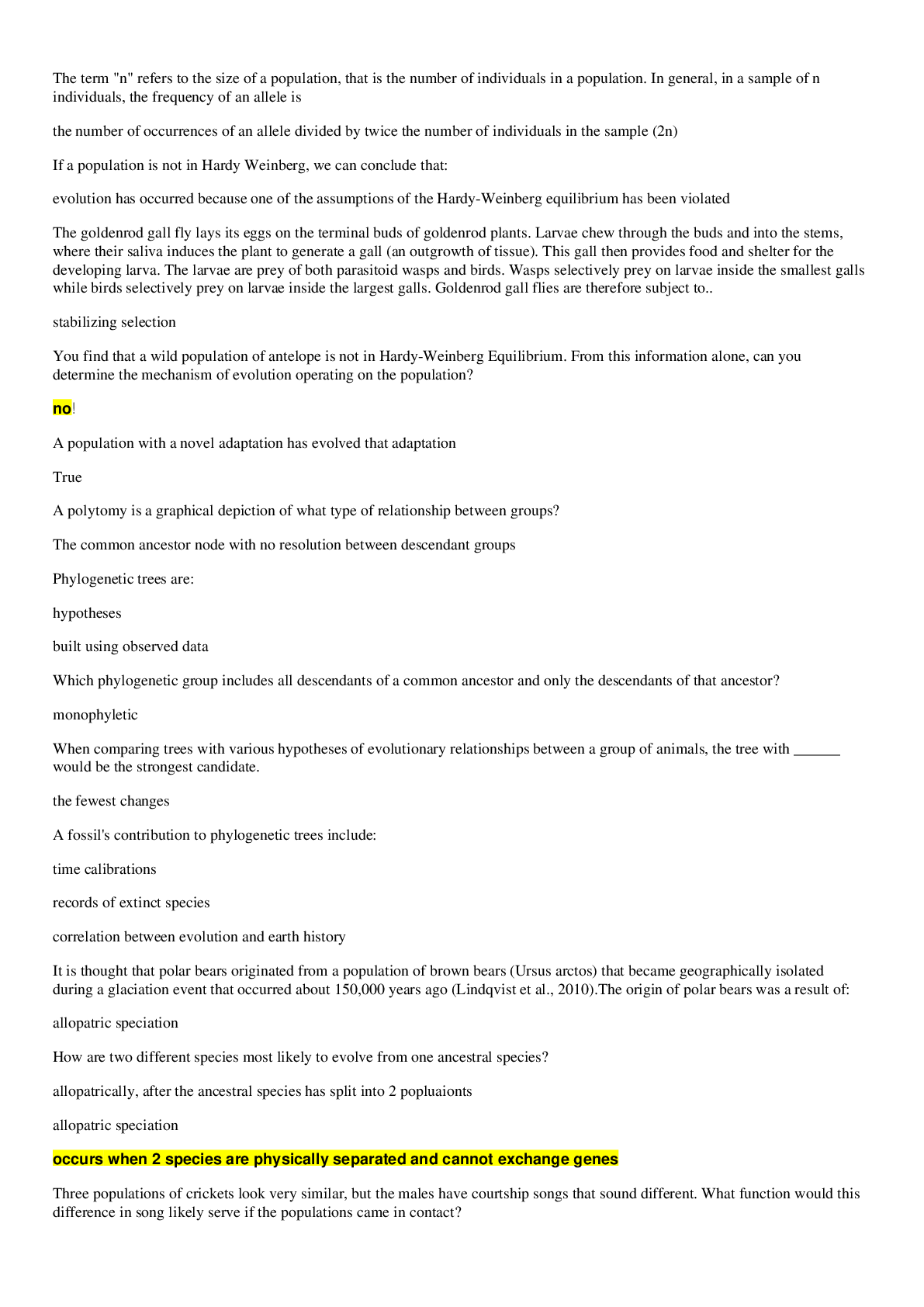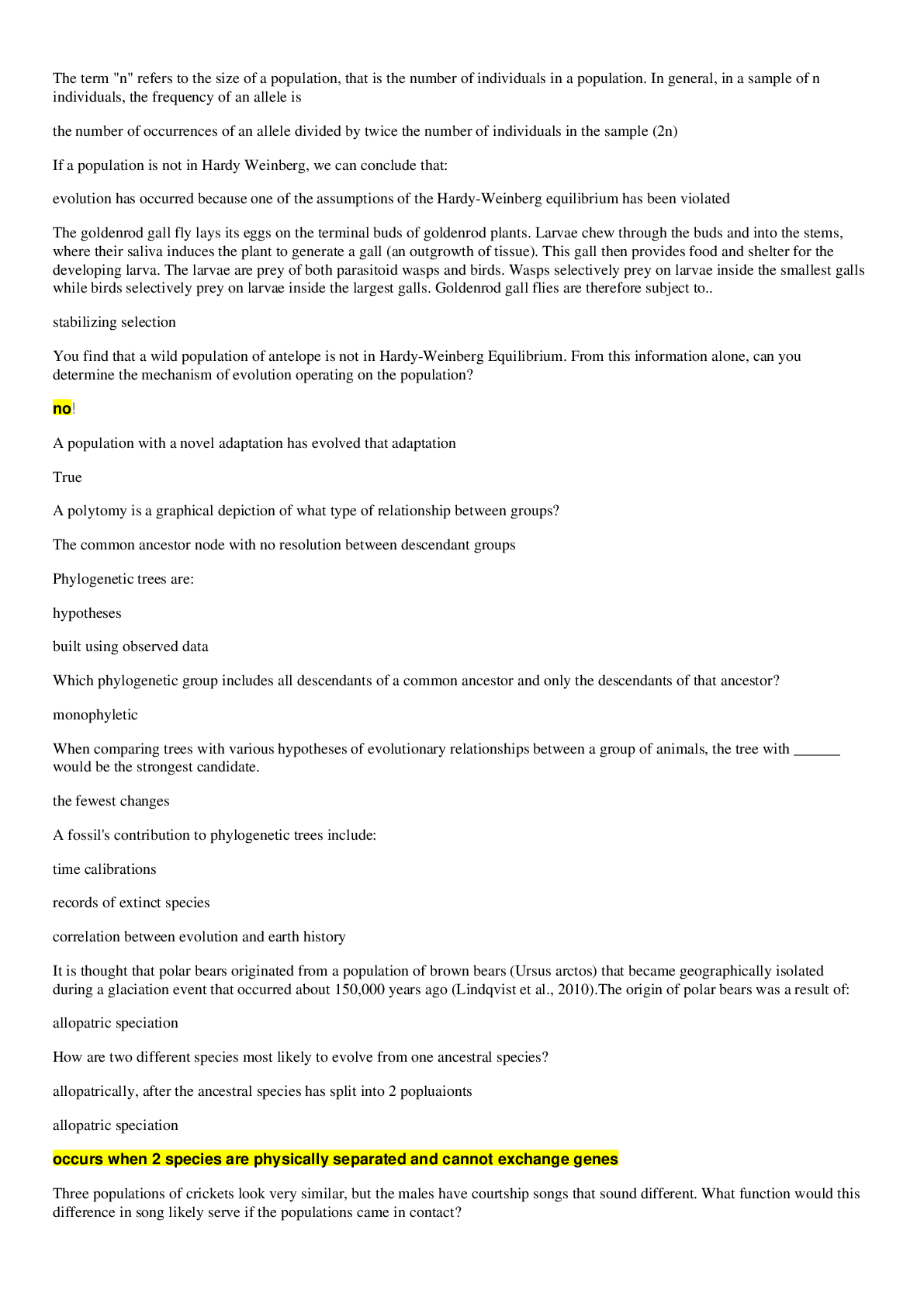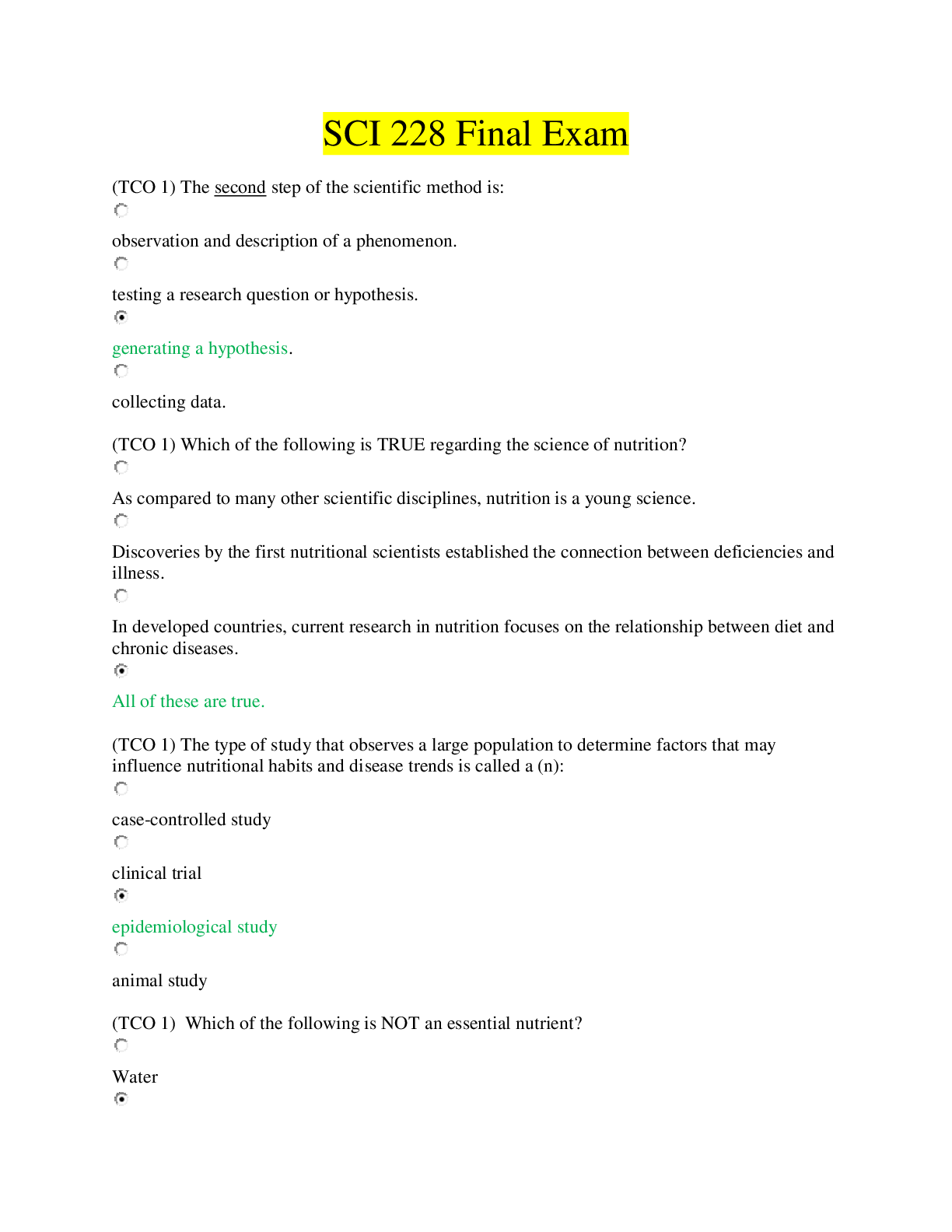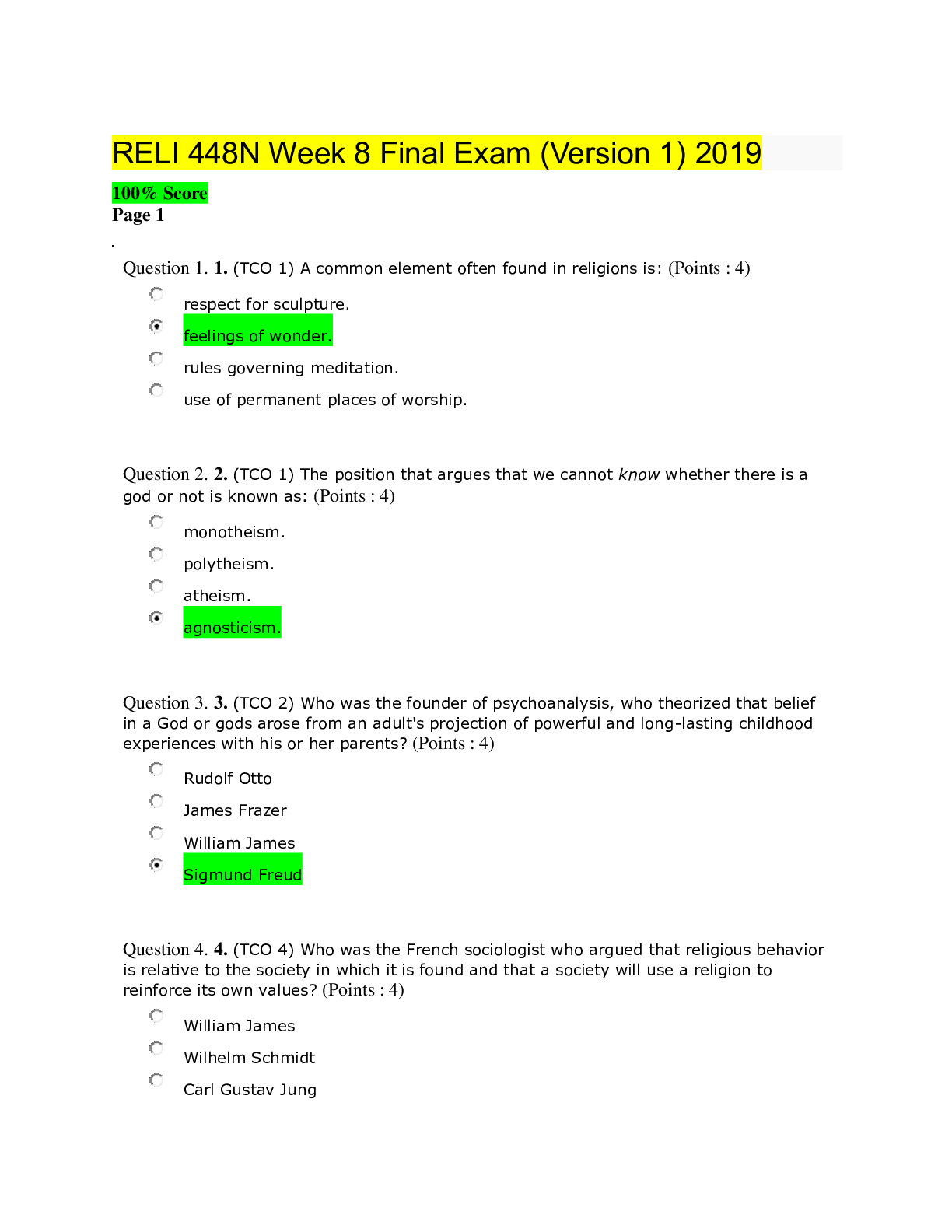Religious Studies > EXAM > RELI-448N Week 8 Final Exam - Download Paper- Graded An A+ (All)
RELI-448N Week 8 Final Exam - Download Paper- Graded An A+
Document Content and Description Below
RELI 448N Week 8 Final Exam Grading Summary Grade Details - All Questions Page: 12 1. Question : Student Answer: (TCO 1) The word religion literally means: to bind. meditate on. w... orship. rise above. 2. Question : Student Answer: (TCO 1) The position that argues that we cannot know whether there is a god or not is known as: monotheism. polytheism. atheism. agnosticism. (TCO 2) Who wa3s.tQhueeGstieornm:an theologian who argued in The Idea of the Holy that religions emerge when people experience that aspect of reali William James Carl Gustav Jung Rudolf Otto E.B. Tylor Student Answer: & Page 1 of 6 4. Question : (TCO 4) Who was the Scottish anthropologist & author of The Golden Bough who saw the origins of religion in early attempts by human beings to influence nature & who identified religion as an intermediate stage between magic & science? Student Answer: James Frazer Rudolf Otto William James Wilhelm Schmidt 5. Question : (TCO 4) What is the name of the Austrian ethnographer and philologist who argued that all humankind once believed in a single High God & that to this simple monotheism later beliefs in lesser gods & spirits were added? Student Answer: James Frazer William James Wilhelm Schmidt Carl Gustav Jung 6. Question : (TCO 8) Vedic religion was: Student Answer: patriarchal & polytheistic. matriarchal & polytheistic. monotheistic. monistic. 7. Question : (TCO 8) The power of a god is often symbolized by: Student Answer: lightening bolts. rings of fire. animals. many arms. 8. Question : (TCO 9) Hinduism, as formulated in the Upanishads, Student Answer: encourages meditation to underst& the essence of reality. says we must honor our social obligations & roles. rejected the authority of the Vedas in formulating new religious insights. advocates devotion to any of the many gods. Page 2 of 6 Comments: 9. Question : (TCO 10) Both Jainism & Sikhism: Student Answer: practice vegetarianism. advocate ahimsa. are monotheistic. view the human being as composite of spirit & matter. 10. Question : (TCO 8) According to the Buddha, his teachings must be: Student Answer: accepted on faith. experienced by oneself. memorized & chanted. spread by missionaries. 11. Question : (TCO 8) Once a person reaches nirvana: Student Answer: suffering continues only for this life. samsara is attained. rebirth is finished. the Pure L& is entered. 12. Question : (TCO 8 ) The Chinese word for "righteousness," "benevolence," "humanity-at-its-best" is: Student Answer: Ren (jen). Li. Wen. Hsiao (xiao). 13. Question : (TCO 8) Confucius thought the most important relationship was: Student Answer: ruler-subject. husband-wife. father-son. friend-friend. 14. Question : (TCO 9) Which is not a Daoist value? Student Answer: Simplicity Spontaneity Sensing movements of nature Formal education Comments: 15. Question : (TCO 9) In Zhuangzi's (Chuang Tzu's) famous dream, he was not certain that he was not: Student Answer: Confucius. an ox. a butterfly. a Daoist. Comments: 16. Question : (TCO 5) All of the following ancient world religions are minor religions except: Student Answer: Shinto. Buddhism. Taoism. Jainism. Comments: 17. Question : (TCO 11) Sikhism is charaterized by: Student Answer: special clothing & religious militarism. special clothing but not religious militarism. religious militarism but not special clothing. special clothing only. Comments: 18. Question : (TCO 6) A contract between the Hebrews & their God was called a: Student Answer: mitzvah. covenant. yarmulke. commandment. 19. Question : (TCO 6) The sacred core of the Hebrew Bible is called the: Student Answer: Torah. Talmud. Writings. Prophets. Comments: 20. Question : (TCO 6) A joyful spring festival that recalls the Hebrews' exodus from Egypt & freedom from oppression is: Student Answer: Yom Kippur. Passover (Seder). Purim. Hanukkah. Comments: 21. Question : (TCO 7) Jesus sometimes summed up his teachings in: Student Answer: ten commandments. one commandment. two commandments. Comments: five commandments. 22. Question : (TCO 7) The most Jewish of the Gospels is: Student Answer: Matthew. Mark. Luke. John. Comments: 23. Question : (TCO 6) Muhammad's job before he became a prophet was as a: Student Answer: merchant. date grower. caravan driver. camel breeder. * Times are displayed in (GMT-07:00) Mountain Time (US & Canada) Grading Summary These are the automatically computed results of your exam. Gra ection below. Question Type: # Of Questions: # Correct: Multiple Choice 25 22 Essay 4 N/A Grade Details - All Questions Page: 1 2 1. Question : (TCO 4) Compare & contrast Sigmund Freud's theory about the origin of religions with William James's theory. How does each of these psychologists view religion (positively or negatively)? Now analyze how the insights of Freud or James might illuminate your religious tradition or the tradition with which you are the most familiar. How would Freud or James underst& that tradition? Use specific examples to support your answer (e.g., a specific belief or ritual). Student Answer: Sigmund Freud’s theory on the origin of religions shows a negative view on religion. Freud theorized that our belief in God comes from impressions made upon us as children by our parents (Molly, 2012, p. 11). Our parents tend to project their image of God upon us that was instilled in them by their parents. Freud also argued that the major function of religion is to control human beings & give them a feeling that they are secure & safe. William James on the other h& view religion as a positive way of fulfilling our needs & he praised religions positive influence on the life of the individuals (Molly, 2012, p. 11). I would say that Sigmund Freud’s of William James’s theories do not have an impact on my religious beliefs as a catholic. I do agree with what James wrote about religion leading to a “harmonious relation with the universe” (Molly, 2012, p. 11). Because of this quote, I think that James would underst& my religious tradition of Sunday Mass. Especially when we come to the part of Mass when we proclaim to others in the congregation “peace be with you”. This act is a direct representation of our will to be at peace with our neighbors. [Molloy, Michael (2010). Experiencing the World’s Religions (5th ed.). New York: McGraw-Hill.] 2. Question : (TCO 9) Identify & analyze the Four Noble Truths, in particular, the Noble Eightfold Path. What ideas from Hinduism did Buddhism essentially keep? Describe them. Include enough details to support your answer. Student Answer: The four noble truths are a linked chain of truths about life: to live is to suffer, suffering comes from desire, to end suffering end desire, & release from suffering is possible & can be attained by following the noble eight fold path (Molly, 2012, p. 135). The meaning of the first noble truth “to live is to suffer” references that we live in a world that is troubling & full of suffering. So, from that day that we are born until the day we die, our lives will be full of suffering. The meaning of the second noble truth “suffering comes from desire” shows a basic human quality that we want what we don’t have & that we are never happy with what we do have. The third noble truth “to end suffering end desire” is accomplished by ridding us of desire by removing what we desire. By living a basic life devoid of adornments we can come to terms with what we have as opposed to what we want. The fourth noble truth “release from suffering is possible & can be attained by following the noble eightfold path” comes from obtaining an inner peace or nirvana. The fourth truth is telling us that to obtain nirvana we need to follow the four noble truths & the eightfold path. The way to inner peace is to follow the eightfold path steps: right understanding, right intention, right speech, right action, right work, right effort, right meditation, & right contemplation. By following these steps we can obtain inner peace or nirvana, which is said to be an end to karma & rebirth. [Molloy, Michael (2010). Experiencing the World’s Religions (5th ed.). New York: McGraw-Hill.] Comments: 3. Question : (TCO 3) Explain & evaluate Thomas Aquinas' Cosmological Argument for the existence of God: The first & plainest is the method that proceeds from the point of view of motion. It is certain & in accord with experience, that things on earth undergo change. Now, everything that is moved is moved by something; nothing, indeed, is changed, except it is changed to something which it is in potentiality. Moreover, anything moves in accordance with something actually existing; change itself, is nothing else than to bring forth something from potentiality into actuality. Now, nothing can be brought from potentiality to actual existence except through something actually existing: thus heat in action, as fire, makes fire-wood, which is hot in potentiality, to be hot actually, & through this process, changes itself. The same thing cannot at the same time be actually & potentially the same thing, but only in regard to different things. What is actually hot cannot be at the same time potentially hot, but it is possible for it at the same time to be potentially cold. It is impossible, then, that anything should be both mover & the thing moved, in regard to the same thing & in the same way, or that it should move itself. Everything, therefore, is moved by something else. If, then, that by which it is moved, is also moved, this must be moved by something still different, & this, again, by something else. But this process cannot go on to infinity because there would not be any first mover, nor, because of this fact, anything else in motion, as the succeeding things would not move except because of what is moved by the first mover, just as a stick is not moved except through what is moved from the hand. Therefore it is necessary to go back to some first mover, which is itself moved by nothing--& this all men know as God. Briefly explain & then evaluate this proof for the existence of God. Student Answer: The cosmological argument is an argument that was presented by a Dominican priest, Thomas Aquinas (1225-1274) (Molly, 2012, p. 381). This argument was an attempt to prove that God exists by examining the nature of the universe. By showing that exist & it is possible for them not to exist if it were not for the first uncaused event that shows us Gods will. Thomas Aquinas studied the works of Aristotle & concluded that through common observation that an object that is in motion is put in motion by some other object or force (Philosophy of Religion, 2015). Form this Aquinas extrapolated that the unknown force must be God. As far as existence is concerned Aquinas concluded that observation teaches us that nothing can create its self. This again relates that the first object to exist must have been created by God. All in all Aquinas’s cosmological argument is based on that fact the nothing can be or exist without some other force putting that creation in motion. He believed that common since would dictate that the only logical explanation for the first creation or push can only be the work of God. [Molloy, Michael (2010). Experiencing the World’s Religions (5th ed.). New York: McGraw- Hill.] [Philosophy of Religion (2015). Aquinas’ Cosmological Argument for the Existence of God http://www.scandalon.co.uk/philosophy/cosmological_aquinas.htm] 4. Question : (TCO 11) Identify & analyze three basic patterns in indigeneous religions. Use examples from traditional Hawaiian religion to support your answer. Student Answer: The three basic patterns in indigenous religions is a strong relationship with nature, a concept of sacred time & space, & respect for origins (Molly, 2012, p. 41). The Hawaiian culture has a strong tradition of a traditional religion that was well established long before contact with western cultures. Hawaiian kahuna were respected members of the community that often served as healers, prophets & philosophers. It is believed that the kahuna talked with the spirits when conducting healing rituals. Another aspect of the ties that the Hawaiian culture has with nature is the respect that that is focused on natural forces such as the tides, the sky, & volcanic activity. In all the Hawaiian indigenous religion have thousands of deities (Molly, 2012, p. 56). Hawaiian ancestors are also looked on as having a status of divinity. The spirits of these ancestors sometimes appear as animals & act as family guardians. The sacred places of the Hawaiian culture vary in size location & purpose. Some of these sacred places have significant historical & cultural meaning such as the birthplace of a king. It is common in Hawaii to leave a small offering such as a lei or fruits & nuts when visiting these sacred sites. One such site is the Olowalu Petroglyphs that consists of hundreds of ancient rock carvings depicting animals, humans, & figure. [Molloy, Michael Experiencing the World’s Religions (5th ed.). New York: McGraw-Hill.] Comments: Page: 12 * Times are displayed in (GMT-07:00) Mountain Time (US & Canada) [Show More]
Last updated: 1 year ago
Preview 1 out of 10 pages
Instant download
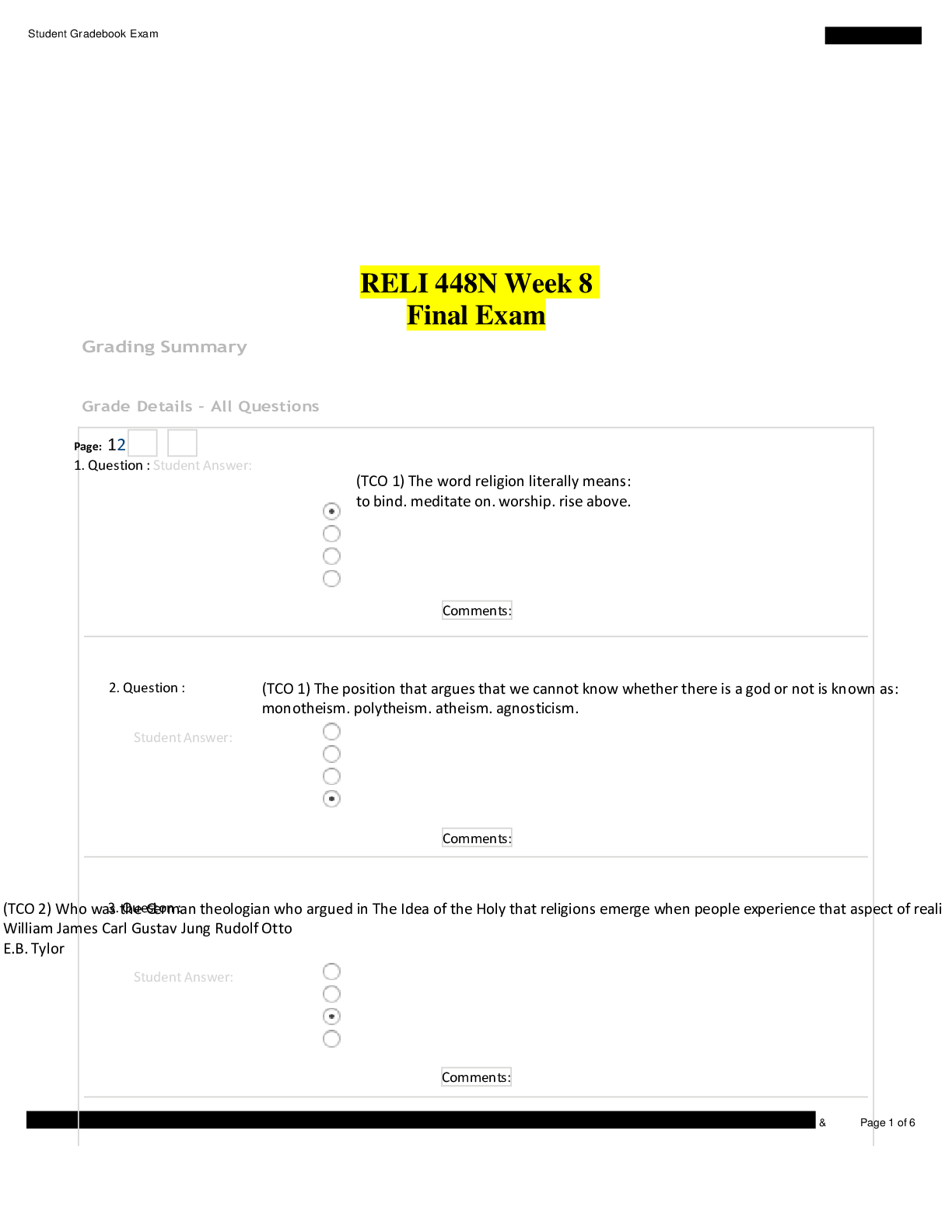
Buy this document to get the full access instantly
Instant Download Access after purchase
Add to cartInstant download
Reviews( 0 )
Document information
Connected school, study & course
About the document
Uploaded On
Jun 13, 2023
Number of pages
10
Written in
Additional information
This document has been written for:
Uploaded
Jun 13, 2023
Downloads
0
Views
49



